|
 Secure Site
Secure Site
|
 |
Archive for February, 2011
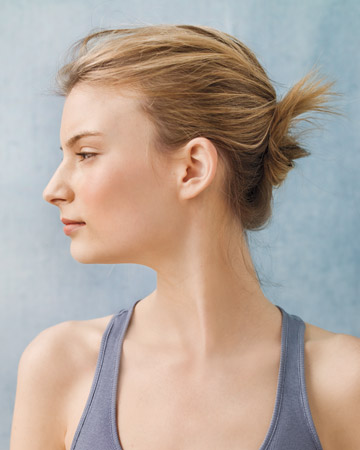 Jaw and Neck Release Stretch The Stress Out
What it does: Releases tension from the jaw, neck, and shoulders; deepens breathing.
How to do it: Sit tall in a chair. Inhale deply; as you exhale, make a “ha” sound, gradually opening your mouth as far as you can without straining your jaw muscles. Let gravity do most of the work. Close your mouth as you inhale and repeat eight to 10 times, opening your mouth wider while using less muscular effort each time.
Now focus on the neck. Still sitting tall, drop your chin toward your chest and take several breaths. Then tilt your head back and look up at the ceiling for several breaths. Bring your head back to the center, inhale, and then turn and look to the right as you exhale. Pause for an inhale, then exhale as you slowly rotate your head to look left. Inhale, then exhale as you rotate your head to the right. Continue until you’ve looked right and left five times each.
adapted from Body + Soul
Use our unique “Zen Clock” which functions as a Yoga Timer. It features a long-resonating acoustic chime that brings your meditation or yoga session to a gradual close, preserving the environment of stillness while also acting as an effective time signal. Our Yoga Timer & Clock can be programmed to chime at the end of the meditation or yoga session or periodically throughout the session as a kind of sonic yantra. The beauty and functionality of the Zen Clock/Timer makes it a meditation tool that can actually help you “make time” for meditation in your life. Bring yourself back to balance.
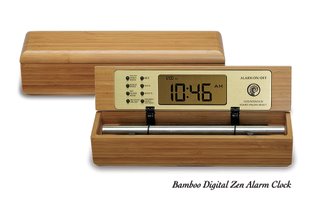 Yoga timers from Boulder, Colorado
Now & Zen – The Yoga Timer Store
1638 Pearl Street
Boulder, CO 80302
(800) 779-6383
Posted in Well-being, yoga, Yoga Timer, Yoga Timers by Now & Zen, Zen Timers
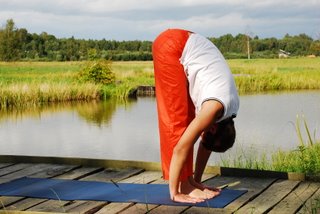 yoga Stretch the Stress Out
What it does: Relieves lower-back aches and releases overworked back muscles, opens hip joints and helps ease sciatic pain, strengthens abdominals and inner thighs.
How to do it: Stand with feet slightly wider than hip-width apart, knees soft. Start to bend forward, hinging at the hips and pressing your palms into your upper thighs; reach your sit bones back (your butt will stick out a bit) to help extend your spine. Continue forward, draping your torso down toward your legs; let your head and arms dangle. Stay for two to three minutes, exhaling with an “s” sound on each breath, then roll up one vertebra at a time.
adapted from Body + Soul Magazine
Use our unique “Zen Clock” which functions as a Yoga Timer. It features a long-resonating acoustic chime that brings your meditation or yoga session to a gradual close, preserving the environment of stillness while also acting as an effective time signal. Our Yoga Timer & Clock can be programmed to chime at the end of the meditation or yoga session or periodically throughout the session as a kind of sonic yantra. The beauty and functionality of the Zen Clock/Timer makes it a meditation tool that can actually help you “make time” for meditation in your life. Bring yourself back to balance.
 Zen Timers and Gentle Alarm Clocks Now & Zen – The Chime Yoga Store
1638 Pearl Street
Boulder, CO 80302
(800) 779-6383
Posted in Bamboo Chime Clocks, Well-being
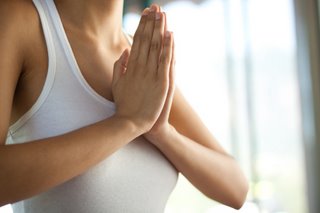 yoga stretch What it does:
Stretches the chest and upper-back muscles, improves posture.
How to do it: Sit tall in a chair. Bend elbows and interlace your hands behind your head. Tilt your head back slightly and let the weight of your head rest in your hands. Lift your spine and chest up toward the ceiling. If it’s comfortable, arch the uppermost portion of your spine slightly back, but keep your focus on lifting up the chest. Stay for up to one minute, breathing deeply and exhaling with an “s” sound.
adapted from Body + Soul Magazine
Use our unique “Zen Clock” which functions as a Yoga Timer. It features a long-resonating acoustic chime that brings your meditation or yoga session to a gradual close, preserving the environment of stillness while also acting as an effective time signal. Our Yoga Timer & Clock can be programmed to chime at the end of the meditation or yoga session or periodically throughout the session as a kind of sonic yantra. The beauty and functionality of the Zen Clock/Timer makes it a meditation tool that can actually help you “make time” for meditation in your life. Bring yourself back to balance.
 Yoga timers and gentle wake up clocks with chimes Now & Zen – The Yoga Timer Store
1638 Pearl Street
Boulder, CO 80302
(800) 779-6383
Posted in Bamboo Chime Clocks, mindfulness practice, Well-being, yoga, Yoga Timer, Yoga Timers by Now & Zen
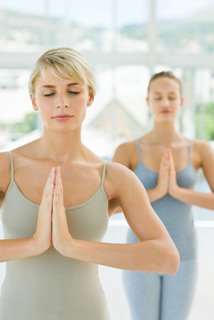 yoga Unless you’re a professional athlete, chances are you’re not getting a balanced workout during your workday. Whether you’re slaving away at a desk, making rounds, or waiting tables, you’re likely straining some muscles while ignoring others, leaving your body feeling stiff, sore, and physically exhausted. Deadlines and pressure from bosses don’t help matters, either.
“When you get stressed, you often hold your breath, which leads to holding your muscles. It feels like you’re wearing a straitjacket,” explains Elaine Petrone, a stress- and pain-management expert and creator of the “Stop the Back Pain” DVD.
You can stretch out the stress, though, with a little time and effort. “By pairing mindful stretches with deep breathing, you’ll make lasting, positive changes to the way your body works, looks, and feels,” says Petrone, who helped us develop this rejuvenating routine. Done for 15 to 20 minutes, three times a week, it paves the way to a calmer, less achy, and more energized you.
adapted from Body + Soul Magazine
Use our unique “Zen Clock” which functions as a Yoga Timer. It features a long-resonating acoustic chime that brings your meditation or yoga session to a gradual close, preserving the environment of stillness while also acting as an effective time signal. Our Yoga Timer & Clock can be programmed to chime at the end of the meditation or yoga session or periodically throughout the session as a kind of sonic yantra. The beauty and functionality of the Zen Clock/Timer makes it a meditation tool that can actually help you “make time” for meditation in your life. Bring yourself back to balance.
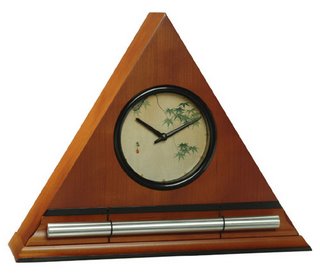 Zen Alarm Clocks and Yoga Timers with Gentle Chime Now & Zen – The Yoga Timer Store
1638 Pearl Street
Boulder, CO 80302
(800) 779-6383
Posted in Bamboo Chime Clocks, Well-being, yoga, Yoga Timer, Yoga Timers by Now & Zen, Zen Timers
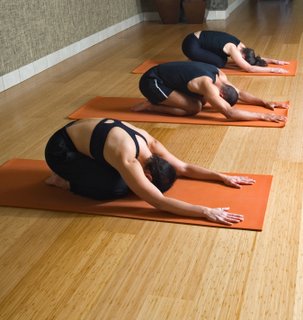 How to avoid yoga injuries “While yoga can certainly help you recover from injury, like any physical activity, it can also lead to one if you’re not careful. According to the U.S. Consumer Product Safety Commission, there were an estimated 5,000 reported injuries due to yoga practice in 2005. “Distinguishing pain from a really good stretch takes a little practice,” explains Baxter Bell, M.D., a Petaluma, California-based yoga teacher, physician, and medical acupuncturist. He offers these tips to reduce your risk of getting hurt.
1. Talk to your teacher before class. Your instructor can help you modify your poses to accommodate an injury, but only if he or she knows you have one. If your instructor doesn’t have good advice on how to approach your special need, consider looking for another instructor.
2. Don’t exceed your limits. Beginning students, especially, tend to push a little too hard.
3. Pay attention to hot spots. The knees, lower back, sacrum, wrists, and shoulders — observe all of these areas as you practice.
4. Use props. In a pose like Triangle, a block can help you come out of the depth of the pose.
5. Talk to your teacher after class. If something hurts as a result of your practice, let your teacher know so that the next class will be better.
6. Take post-practice care. Ice any sore spots or consider taking a natural anti-inflammatory.
adapted from Body + Soul, October 2007
Use our unique “Zen Clock” which functions as a Yoga Timer. It features a long-resonating acoustic chime that brings your meditation or yoga session to a gradual close, preserving the environment of stillness while also acting as an effective time signal. Our Yoga Timer & Clock can be programmed to chime at the end of the meditation or yoga session or periodically throughout the session as a kind of sonic yantra. The beauty and functionality of the Zen Clock/Timer makes it a meditation tool that can actually help you “make time” for meditation in your life. Bring yourself back to balance.
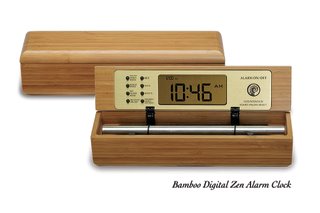 Bamboo Yoga Timer for Yoga Now & Zen – The Yoga Timer Store
1638 Pearl Street
Boulder, CO 80302
(800) 779-6383
Posted in yoga
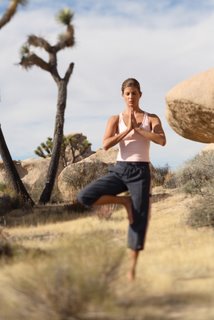 yoga When its popularity in America first began to soar — along with the celebrity endorsements — you wouldn’t hear yoga mentioned without the word “trend.” For sure, commercial interests continue to fuel this misnomer (you can actually purchase Diet Coke yoga pants). But yoga has long since proven its staying power, in part because of its success as both a physical and emotional therapy. “Trends come and go, but yoga is popular because it works,” says Richard Faulds, former president of Kripalu and author of “Kripalu Yoga: A Guide to Practice On and Off the Mat.” “Science is studying it,” he adds, “and frankly? It’s kicking butt.”
From relieving carpal tunnel to helping cancer survivors with recovery, yoga’s benefits have made news in various medical publications, including the Journal of the American Medical Association. Nearly half of the hospitals surveyed for the American Hospital Association provide an Eastern method of exercise or therapy, including yoga. Even some insurance companies have gotten on board, helping their clients pay for classes.
As rosy as the yoga scene looks, the future holds even more promise. “As younger people see the difference in mobility between older people who have practiced yoga and those who haven’t, yoga will continue to grow in popularity,” predicts Sandy Blaine, a 14-year veteran teacher, cofounder of the Alameda Yoga Station in Alameda, California, and author of “Yoga for Healthy Knees.” “We’ve started to see yoga crop up in schools and PE classes; perhaps we’ll someday witness a widespread acceptance of its philosophical foundation.”
With millions of Americans practicing yoga — these days, it’s not so much a question of who does yoga, but who doesn’t — it may just be a matter of time. From preschoolers to senior citizens, new moms to Navy SEALs, everyone seems to find something to like in this ancient Eastern discipline. Some expect (and get) a deeply spiritual experience, enriched by chanting, prayer, and meditation; others are in it for the ripped abs and glutes of steel. Regardless of what draws a person in initially, yoga has a way of delivering rewards that go well beyond the expected. “The key,” says Faulds, “is learning how to enter the practice in a way that works for you.”
Use our unique “Zen Clock” which functions as a Yoga Timer. It features a long-resonating acoustic chime that brings your meditation or yoga session to a gradual close, preserving the environment of stillness while also acting as an effective time signal. Our Yoga Timer & Clock can be programmed to chime at the end of the meditation or yoga session or periodically throughout the session as a kind of sonic yantra. The beauty and functionality of the Zen Clock/Timer makes it a meditation tool that can actually help you “make time” for meditation in your life. Bring yourself back to balance.
adapted from Body + Soul, October 2007
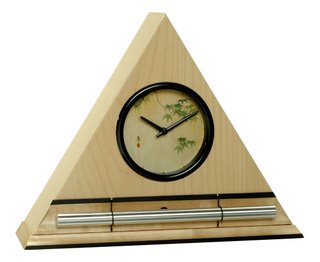 Zen Alarm Clock with Japanese Maple Leaves Now & Zen – The Yoga Timer Store
1638 Pearl Street
Boulder, CO 80302
(800) 779-6383
Posted in Bamboo Chime Clocks
 give stress a rest They were the butt of the joke when uttered by Stuart Smalley, the self-help guru from “Saturday Night Live.” Kidding aside, affirmations are a powerful way to combat stress. “They bring you back inside yourself instantly, making you calm and focused,” says Kathleen Hall, CEO of the Stress Institute and author of “A Life in Balance.” If the idea of chanting a self-affirming mantra makes you cringe, consider this: A study published in Psychology Science showed that affirmations reduced cortisol (a stress hormone) responses to stress. Use a positive statement that speaks to your particular need. If your stress is fear-based, try “I’m protected and guided.” If you’re feeling anxious, think, “I’m calm and balanced.” Repeat the words to yourself until you feel your outlook take a turn for the better.
adapted from Wholeliving.com
Use our unique “Zen Clock” which functions as a Yoga & Meditation Timer. It features a long-resonating acoustic chime that brings your meditation or yoga session to a gradual close, preserving the environment of stillness while also acting as an effective time signal. Our Yoga Timer & Clock can be programmed to chime at the end of the meditation or yoga session or periodically throughout the session as a kind of sonic yantra. The beauty and functionality of the Zen Clock/Timer makes it a meditation tool that can actually help you “make time” for meditation in your life. Bring yourself back to balance.
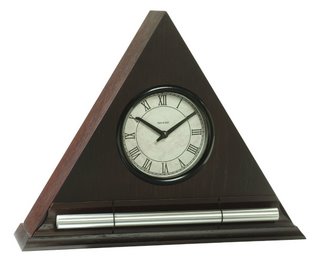 Zen Alarm Clocks with Gentle Chime Now & Zen – The Meditation Timer Store
1638 Pearl Street
Boulder, CO 80302
(800) 779-6383
Posted in Bamboo Chime Clocks
 lavendar The best herbs to relax after the holiday season.
Shopping, relatives, money—stress. The holiday season is supposed to be a time of joy, but it can also be exhausting. We asked some herbalists and health-care providers to suggest ways to relax after the holidays.
Relieve tension by filling a sachet with dried hops. Tuck it next to your pillow and settle down for a peaceful sleep. The aroma of hops is mildly sedative.
—Portia Meares, herbalist and author, Wolftown, VA
Unwind by soaking in a bath scented with a few drops of lavender oil.
Curl up with a cup of lemon-balm tea. Place 1 tablespoon of the dried herb in a tea ball, drop it in a teacup, add hot water. Set your Zen Timer with Chime and steep for 10 minutes.
Escape to a sunny vacation spot where you can relax in seclusion. People should vacation in winter, rather than summer; sunny weather gives people stamina to juggle busy schedules, while cold, short winter weather depletes energy.
—Paul Bergner, clinic director at the Rocky Mountain Center for Botanical Studies, Boulder, CO
Nourish the nervous system with herbal adaptogens such as oat seed. This herb contains alkaloids, believed to protect and rebuild the myelin sheath surrounding nerve cells. Take 30 drops of the extract twice a day.
Inhale the calming scent of rosemary essential oil. Mix a few drops into hand lotion or place a drop or two on a cotton ball.
—Feather Jones, practicing herbalist and owner of Turtle Island Herbs, Boulder, CO
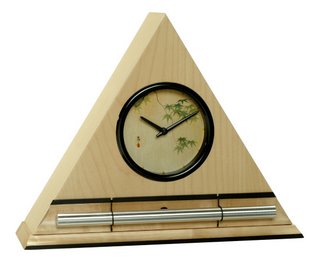 Zen Alarm Clock with Gentle Chime for Stress Reduction
Now & Zen
1638 Pearl Street
Boulder, CO 80302
(800) 779-6383
Posted in intention, nature, Now & Zen Alarm Clocks, wake up alarm clock
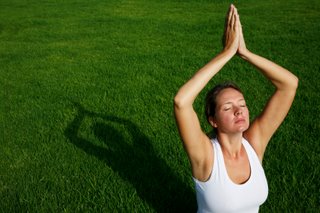 Outdoor Yoga That most familiar of asana sequences, Surya Namaskar (Sun Salutation) is as rich in symbolic and mythic overtones as it is in physical benefits.
In many cultures, light has long been a symbol of consciousness and self-illumination. “The world begins with the coming of light,” wrote Jungian analyst Erich Neumann in The Origins and History of Consciousness (Princeton University Press, 1995). “Opposition between light and darkness has informed the spiritual world of all peoples and molded it into shape.”
Our primary source of light is, of course, the sun. When we look at our closest star, we may see nothing more than a big yellow ball. But for thousands of years, the Hindus have revered the sun, which they call Surya, as both the physical and spiritual heart of our world and the creator of all life itself. That’s why one of Surya’s many other appellations is Savitri (the Vivifier), who, according to the Rig Veda, “begets and feeds mankind in various manners” (III.55.19). Moreover, since everything that exists originates from the sun, as Alain DaniŽlou wrote in The Myths and Gods of India (Inner Traditions, 1991), it “must contain the potentiality of all that is to be known.” For the Hindus, the sun is the “eye of the world” (loka chakshus), seeing and uniting all selves in itself, an image of and a pathway to the divine.
One of the means of honoring the sun is through the dynamic asana sequence Surya Namaskar (better known as Sun Salutation). The Sanskrit word namaskar stems from namas, which means “to bow to” or “to adore.” (The familiar phrase we use to close our yoga classes, namaste—te means “you”—also comes from this root.) Each Sun Salutation begins and ends with the joined-hands mudra (gesture) touched to the heart. This placement is no accident; only the heart can know the truth.
The ancient yogis taught that each of us replicates the world at large, embodying “rivers, seas, mountains, fields…stars and planets…the sun and moon” (Shiva Samhita, II.1-3). The outer sun, they asserted, is in reality a token of our own “inner sun,” which corresponds to our subtle, or spiritual, heart. Here is the seat of consciousness and higher wisdom (jnana) and, in some traditions, the domicile of the embodied self (jivatman).
It might seem strange to us that the yogis place the seat of wisdom in the heart, which we typically associate with our emotions, and not the brain. But in yoga, the brain is actually symbolized by the moon, which reflects the sun’s light but generates none of its own. This kind of knowledge is worthwhile for dealing with mundane affairs, and is even necessary to a certain extent for the lower stages of spiritual practice. But in the end, the brain is inherently limited in what it can know and is prone to what Patanjali calls misconception (viparyaya) or false knowledge of the self.
The eight basic postures, in order of performance, are Tadasana (Mountain Pose), Urdhva Hastasana (Upward Salute), Uttanasana (Standing Forward Bend), Lunge, Plank Pose, Chaturanga Dandasana (Four-Limbed Staff Pose), Urdhva Mukha Svanasana (Upward-Facing Dog Pose), and Adho Mukha Svanasana (Downward-Facing Dog Pose).
The transition from posture to posture is facilitated by either an inhalation or an exhalation. As you move through the sequence, watch your breath closely. Slow your pace or stop and rest entirely if your breathing becomes labored or shuts down altogether. Always breathe through your nose, not your mouth: Nasal breathing filters and warms incoming air and slows your breathing down, thereby lending the sequence a meditative quality and reducing the risk of hyperventilation.
To perform the sequence, start in Tadasana, with your hands together at your heart. Inhale and lift your arms overhead to Urdhva Hastasana, then exhale while lowering the arms down and fold your torso into Uttanasana. Then inhale, arch your torso into a slight backbend with the fingertips or palms pressed to the floor or blocks, and exhale while bringing your left foot back into a lunge. Inhale forward to Plank, then exhale and lower yourself into Chaturanga Dandasana. On an inhalation, arch your torso up as you straighten your arms into Upward Dog. Exhale back to Downward Dog; step the left foot forward on an inhalation into Lunge. Swing the right leg forward to Uttanasana on an exhalation, then lift your torso and reach your arms overhead on an inhalation to Urdhva Hastasana. Finally, lower your arms on an exhalation and return to your starting point, Tadasana.
Remember, this is only a half-round; you’ll need to repeat the sequence, switching left to right and right to left to complete a full round. If you’re just starting out, it might help to work on the poses individually before you put them together. (Visit www.YogaJournal.com for more how-to information.)
adapted from Yoga Journal, by Richard Rosen
Use our unique “Zen Clock” which functions as a Yoga Timer. It features a long-resonating acoustic chime that brings your meditation or yoga session to a gradual close, preserving the environment of stillness while also acting as an effective time signal. Our Yoga Timer & Clock can be programmed to chime at the end of the meditation or yoga session or periodically throughout the session as a kind of sonic yantra. The beauty and functionality of the Zen Clock/Timer makes it a meditation tool that can actually help you “make time” for meditation in your life. Bring yourself back to balance.
 Yoga timers from Boulder, Colorado Now & Zen – The Yoga Timer Store
1638 Pearl Street
Boulder, CO 80302
(800) 779-6383
Posted in intention, Now & Zen Alarm Clocks, wake up alarm clock, Well-being, yoga, Yoga Timer, Yoga Timers by Now & Zen
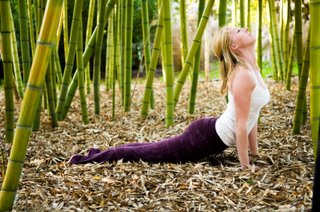 better posture from yoga Your mom was right: You’ll look better and feel great if you stop slouching and stand up straight. Yoga can help you do just that—in a way that honors your spine’s natural curves. Here’s a guide to assessing and improving your posture.
Are you a slumper? A swayer? Chances are you’re one or the other to some degree—despite Mom’s best efforts all those years ago to get you to sit up straight and stop slouching. She probably told you that you’d look and feel better if you worked on your posture, and she was absolutely right. But if you’re like most people, you rolled your eyes and ignored her, or straightened up until she wasn’t looking. And you probably didn’t give posture much more thought at all until you walked into your first yoga class and tried to stand in Tadasana (Mountain Pose).
When you’re a beginner, it’s surprisingly complicated to master the art of rooting down through the feet while lengthening up through the spine, keeping your chest open without jutting your lower ribs out, and keeping the legs muscles strong and lifted without tensing the belly or jaw. But ultimately, Tadasana demands just one simple thing: that you stand in a way that supports the natural curves of a healthy spine. So why is it so difficult? And why do we work so hard to master good posture in yoga—leaving class feeling taller and healthier—only to slump down in the car seat on the way home or revert to a swayback when we heft our overstuffed yoga bags onto our backs?
In short, modern life conspires against good posture. We spend our days sitting at desks, staring at computer screens. When we travel, we do it in cars or—worse—airplanes. We lounge around in overstuffed chairs designed more for looks than for lumbar support. And we pay people to mow our lawns, tend our gardens, and remove our trash so we can spend more time working or driving or sitting. Nonsedentary cultures—with a few exceptions—don’t have the same epidemic of back and neck problems that we do. Picture a woman gracefully balancing a large basket of food on her head. To carry such a heavy weight, she must have a perfectly aligned spine and strong posture-support muscles. You don’t get that kind of alignment and strength from sitting around and watching the tube. You can, however, get it from a regular yoga practice.
Take comfort in knowing that yoga trains your mind as well as your body. As you continue to devote yourself to your practice, you will become more present in your body and more aware of your alignment, and you will begin to naturally make choices that will improve your health and your quality of life. Over time, the combination of increased awareness and physical training will allow your improved alignment to spill out into other areas of your life. Before you know it, you’ll feel at ease as you practice good yoga alignment while you’re perched at your desk, standing at the copier, and sitting at dinner. You’ll be doing yoga during all of your waking hours. And who knows? You might just impress your mom!
adapted fromYoga Journal, by Julie Gudmestad
Use our unique “Zen Clock” which functions as a Yoga Timer. It features a long-resonating acoustic chime that brings your meditation or yoga session to a gradual close, preserving the environment of stillness while also acting as an effective time signal. Our Yoga Timer & Clock can be programmed to chime at the end of the meditation or yoga session or periodically throughout the session as a kind of sonic yantra. The beauty and functionality of the Zen Clock/Timer makes it a meditation tool that can actually help you “make time” for meditation in your life. Bring yourself back to balance.
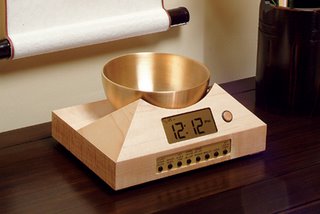 Zen Timepiece, a yoga timer and clock with Tibetan bowl Now & Zen – The Yoga & Meditation Timer Store
1638 Pearl Street
Boulder, CO 80302
(800) 779-6383
Posted in intention, Well-being, yoga, Yoga Timer, Yoga Timers by Now & Zen, Zen Timers
« Previous Entries
Next Page »
|
|
|
|